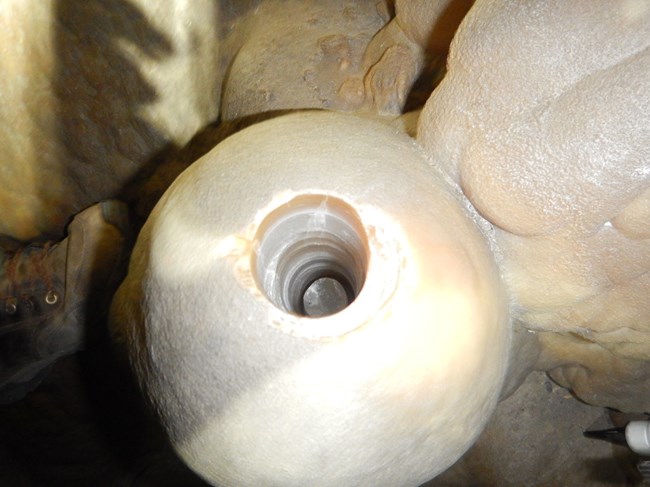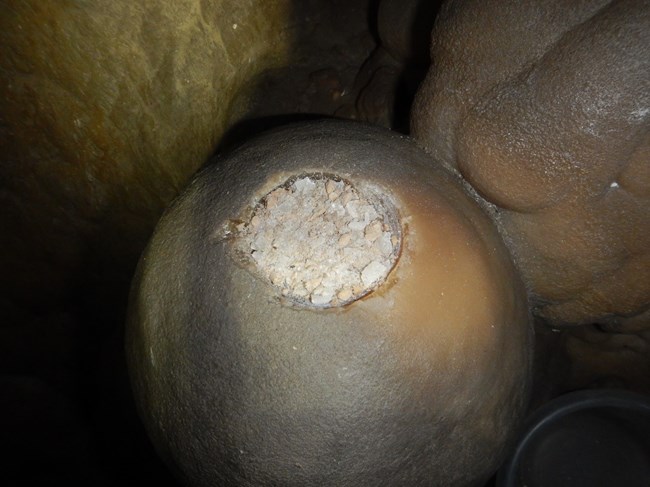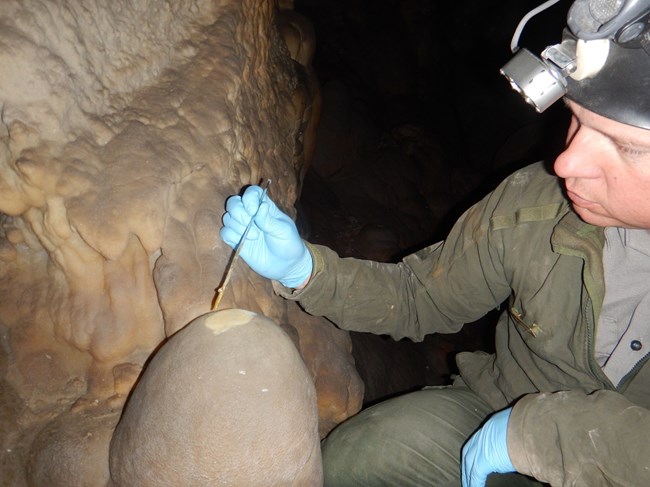Part of a series of articles titled Inside Earth – NPS Cave & Karst News – Summer 2017.
Article
Cave Research Activities and Documented Vandalism

Submitted by Ben Kartchner, Biological Science Technician
Doctoral candidate Brendon Quirk, from the Geology department at the University of Utah, was granted the unique opportunity to take three core samples from the Timpanogos Cave System. Two cores were taken from stalagmites in Hansen Cave and Middle Cave, and another from flowstone in Timpanogos Cave. The purpose of this study is to understand and test the sensitivity of mountain glacier energy-mass balance to proximal pluvial lakes. The Wasatch Mountains were extensively glaciated during the Last Glacial Maximum from approximately 22—19 thousand years ago. During this time, the Bonneville Basin just to the west of the Wasatch Range saw the rise of the largest pluvial lake in North America, Lake Bonneville. Despite much speculation of a lake-effect on the glaciers, no geologic record has of yet been identified. In order to investigate this theory, stable isotope geochemistry will be used on the core samples to tell whether or not Lake Bonneville was generating significant amounts of snow in the geological past. We hope to see the results sometime this year.

Samples are usually taken as a cross section that can destroy most of the formation, but as part of the agreement with the University of Utah, it was decided to take core samples which are less invasive and can allow for future studies. Repairing the cavities left from the core samples presented a unique problem. The cavities were filled using chunks of previously broken cave formations then sealed with a mixture of epoxy EPON 828 and smaller formation granules.

Samples are usually taken as a cross section that can destroy most of the formation, but as part of the agreement with the University of Utah, it was decided to take core samples which are less invasive and can allow for future studies. Repairing the cavities left from the core samples presented a unique problem. The cavities were filled using chunks of previously broken cave formations then sealed with a mixture of epoxy EPON 828 and smaller formation granules.
The trail that leads to Timpanogos Cave is known for being a steep and arduous hike. Rapid uplift in the Wasatch Mountains and heavily fractured geologic units contribute to a high occurrence of rockfalls along the cave trail. This season, Crystal Lambert, an intern from the Geoscientists-in-the-Park (GIP) program will be using an Unstable Slope Management Program (USMP) to evaluate hazardous slopes and provide a risk assessment along the trail. TICA staff expect this project to determine zones of less risk and identify areas of immediate concern for future mitigation.
In 2016 the Hansen Cave entrance door and other areas were vandalized during an attempted break-in. There was only minor damage to facilities and no damage to the inside of the cave. In response to this, motion-detecting security cameras were installed to alert staff of movement at the cave entrance and exit during hours of closure.
Last updated: June 26, 2020
